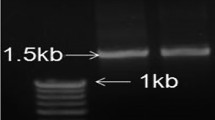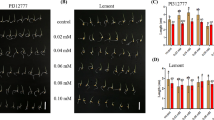Abstract
Gene expression of phenylalanine ammonia-lyase (PAL) in allelopathic rice PI312777 was inhibited by RNA interference (RNAi). Transgenic rice showed lower levels of PAL gene expression and PAL activity than wild type rice (WT). The concentrations of phenolic compounds were lower in the root tissues and root exudates of transgenic rice than in those of wild type plants. When barndyardgrass (BYG) was used as the receiver plant, the allelopathic potential of transgenic rice was reduced. The sizes of the bacterial and fungal populations in rice rhizospheric soil at the 3-, 5-, and 7-leaf stages were estimated by using quantitative PCR (qPCR), which showed a decrease in both populations at all stages of leaf development analyzed. However, PI312777 had a larger microbial population than transgenic rice. In addition, in T-RFLP studies, 14 different groups of bacteria were detected in WT and only 6 were detected in transgenic rice. This indicates that there was less rhizospheric bacterial diversity associated with transgenic rice than with WT. These findings collectively suggest that PAL functions as a positive regulator of rice allelopathic potential.






Similar content being viewed by others
References
Bastiaans, L. and Kropff, M. J. 2003. WEEDS | Weed Competition. Elsevier, Oxford.
Belz, R. G. 2007. Allelopathy in crop/weed interactions: an update. Pest Manag. Sci. 63:308–326.
Bertin, C., Yang, X. H., and Weston, L. A. 2003. The role of root exudates and allelochemicals in the rhizosphere. Plant Soil 256:67–83.
Bi, H. H., Zeng, R. S., Su, L. M., An, M., and Luo, S. M. 2007. Rice allelopathy induced by methyl jasmonate and methyl salicylate. J. Chem. Ecol. 33:1089–1103.
Camacho-Cristal, J. J., Anzellotti, D., and Gonzez-Fontes, A. 2002. Changes in phenolic metabolism of tobacco plants during short-term boron deficiency. Plant Physiol. Biochem. 40:997–1002.
Chauhan, B. S. and Johnson, D. E. 2011. Row spacing and weed control timing affect yield of aerobic rice. Field Crops. Res. 121:226–231.
Chung, I. M., Kim, J. T., and Kim, S. H. 2006. Evaluation of allelopathic potential and quantification of momilactone A, B from rice hull extracts and assessment of inhibitory bioactivity on paddy field weeds. J. Agric. Food Chem. 54:2527–2536.
Cipollini, D., Rigsby, C. M., and Barto, E. K. 2012. Microbes as targets and mediators of allelopathy in plants. J. Chem. Ecol. 38:714–727.
Dickerson, D. P., Pascholati, S. F., Hagerman, A. E., Butler, L. G., and Nicholson, R. L. 1984. Phenylalanine ammonia-lyase and hydroxycinnamate: CoA ligase in maize mesocotyls inoculated with Helminthosporium maydis or Helminthosporium carbonum. Physiol. Plant Pathol. 25:111–123.
Dilday, R. H., Lin, J., and Yan, W. 1994. Identification of allelopathy in USDA-ARS 320 rice germplasm collection. Aust. J. Exp. Agric. 34:907–910.
Fang, C. X., Xiong, J., Qiu, L., Wang, H. B., Song, B. Q., He, H. B., Lin, R. Y., and Lin, W. X. 2009. Analysis of gene expressions associated with increased allelopathy in rice (Oryza sativa L.) induced by exogenous salicylic acid. Plant Growth Regul. 57:163–172.
Fang, C. X., Wang, Q. S., Yu, Y., Li, Q. M., Zhang, H. L., Wu, X. C., Chen, T., and Lin, W. X. 2011. Suppression and overexpression of Lsi1 induce differential gene expression in rice under ultraviolet radiation. Plant Growth Regul. 65:1–10.
Ferrer, J. L., Austin, M. B., Stewart Jr., C., and Noel, J. P. 2008. Structure and function of enzymes involved in the biosynthesis of phenylpropanoids. Plant Physiol. Biochem. 46:356–370.
Gealy, D., Moldenhauer, K., and Duke, S. 2013. Root distribution and potential interactions between allelopathic rice, sprangletop (Leptochloa spp.), and barnyardgrass (Echinochloa crus-galli) based on 13C isotope discrimination analysis. J. Chem. Ecol. 39:186–203.
He, H. Q., Lin, W. X., Liang, Y. Y., Song, B. Q., Ke, Y. Q., Guo, Y. C., and Liang, K. J. 2005. Analyzing the molecular mechanism of crop allelopathy by using differential proteomics. Acta Ecol. Sin. 25:3141–3146 (in Chinese with English abstract).
He, H. B., Wang, H. B., Fang, C. X., Lin, Z. H., Yu, Z. M., and Lin, W. X. 2012a. Separation of allelopathy from resource competition using rice/barnyardgrass mixed-cultures. PLoS One 7:e37201. doi:10.1371/journal.pone.0037201.
He, H. B., Wang, H. B., Fang, C. X., Wu, H. W., Guo, X. K., Liu, C. H., Lin, Z. H., and Lin, W. X. 2012b. Barnyard grass stress up regulates the biosynthesis of phenolic compounds in allelopathic rice. J. Plant Physiol.. doi:10.1016/j.jplph.2012.06.018.
Höfgen, R. and Willmitzer, L. 1988. Storage of competent cells for Agrobacterium transformation. Nucleic Acids Res. 16:9877.
IRRI (International Rice Research Institute). 1993. Rice Almanac 1993–95. IRRI, P.O. Box: 933, 1099 Manila, Philippines
Jefferson, R. A. 1989. The GUS reporter system. Nature 342:837Y838.
Johnson, D. E., Wopereis, M. C. S., Mbodj, D., Diallo, S., Powers, S., and Haefele, S. M. 2004. Timing of weed management and yield losses due to weeds in irrigated rice in the Sahel. Field Crop Res. 85:31–42.
Kato-Noguchi, H. 2011. Barnyard grass-induced rice allelopathy and momilactone B. J. Plant Physiol. 168:1016–1020.
Kato-Noguchi, H. and Peters, R. J. 2013. The role of momilactones in rice allelopathy, J. Chem. Ecol. 39:175–185.
Kato-Notuchi, H., Tamura, K., Sasaki, H., and Suenaga, K. 2012. Identification of two phytotoxins, blumenol A and grasshopper ketone, in the allelopathic Japanese rice variety Awaakamai. J. Plant Physiol. 169:682–685.
Lehoczky, E., Nelima, M. O., Szabó, R., Szalai, A., and Nagy, P. 2011. Allelopathic effect of Bromus spp. and Lolium spp. shoot extracts on some crops. Commun. Agric. Appl. Biol. Sci. 76:537–554.
Lin, R. Y., Rong, H., Zhou, J. J., Yu, C. P., Ye, C. Y., Chen, L. S., and Lin, W. X. 2007. Impact of allelopathic rice seedlings on rhizospheric microbial populations and their functional diversity. Acta Ecol. Sin. 27:3644–3654.
Lin, R. Y., Wang, H. B., Guo, X. K., Ye, C. Y., He, H. B., Zhou, Y., and Lin, W. X. 2011. Impact of applied phenolic acids on the microbes, enzymes and available nutrients in paddy soils. Allelopathy J. 28:225–236.
Lowry, O. H., Rosebrough, N. J., Farr, A. L., and Randall, R. J. 1951. Protein measurement with the Folin phenol reagent. J. Biol. Chem. 193:265–275.
Macdonald, M. J. and D’Cunha, G. B. 2007. A modern view of phenylalanine ammonia lyase. Biochem. Cell Biol. 85:273–282.
Macias, F. A., Chinchilla, N., Varela, R. M., and Molinllo, J. M. G. 2006. Bioactive steroids from Oryza sativa L. Steroids 71:603–608.
Mattice, J., Lavy, T., Skulman, B., and Dilday, R. H. 1998. Searching for allelochemicals in rice that control ducksalad, pp. 81–98, in M. Olofsdotter (ed.), Allelopathy in Rice. Proceeding of the Workshop on Allelopathy in Rice. International Rice Research Institute, Manila, Philippines.
Peršoh, D., Theuerl, S., Buscot, F., and Rambold, G. 2008. Towards a universally adaptable method for quantitative extraction of high-purity nucleic acids from soil. J. Microbiol. Meth. 75:19–24.
Seal, A. N., Pratley, J. E., Haig, T., and An, M. 2004. Identification and quantitation of compounds in a series of allelopathic and non-allelopathic rice root exudates. J. Chem. Ecol. 30:1647–1662.
Shen, Y., Jin, L., Xiao, P., Lu, Y., and Bao, J. S. 2009. Total phenolics, flavonoids, antioxidant capacity in rice grain and their relations to grain color, size and weight. J. Cereal Sci. 49:106–111.
Shin, D. H., Kim, K. U., Sohn, D. S., Kang, S. G., Kim, H. Y., Lee, I. J., and Kim, M. Y. 2000. Regulation of gene expression related to allelopathy, pp. 109Y24, in K. U. Kim and D. H. Shin (eds.), Rice Allelopathy. Proceedings of the Workshop in Rice Allelopathy. Kyungpook National University, Korea, Taegu.
Singleton, V. L., Orthofer, R., and Lamuela-Raventós, R. M. 1999. Analysis of total phenols and other oxidation substrates and antioxidants by means of folin-ciocalteu reagent. Methods Enzymol. 299:152–178.
Song, B. Q., Xiong, J., Fang, C. X., Qiu, L., Lin, R. Y., Liang, Y. Y., and Lin, W. X. 2008. Allelopathic enhancement and differential gene expression in rice under low nitrogen treatment. J. Chem. Ecol. 34:688–695.
Supartana, P., Shimizu, T., Shioiri, H., Nogawa, M., Nozue, M., and Kojima, M. 2005. Development of simple and efficient in planta transformation method for rice (Oryza sativa L.) using Agrobacterium tumefaciens. J. Biosci. Bioeng. 4:391–397.
Walker, T. S., Bais, H. P., Grotewold, E., and Vivanco, J. M. 2003. Root exudation and rhizosphere biology. Plant Physiol. 132:44–51.
Wang, H. B., Yu, Z. M., He, H. B., Guo, X. K., Huang, J. W., Zhou, Y., Xu, Z. B., and Lin, W. X. 2012. Relationship between allelopathic potential and grain yield of different allelopathic rice accessions. Chin. J. Eco-Agric. 20:75–79 (in Chinese with English abstract).
Worthington, M. and Reberg-Horton, S. C. 2013. Breeding cereal crops for enhanced weed suppression: optimizing allelopathy and competitive ability. J. Chem. Ecol. 39:2. 39:213–231.
Xu, Z. H., Guo, D. P., Yu, L. Q., Zhao, M., Zhang, X., Li, D., Zheng, K. L., and Ye, Y. L. 2003. Molecular biological study on the action mechanism of rice allelochemicals against weeds. Chin. J. Appl. Ecol. l4:829–833. in Chinese with English abstract.
Xu, M., Galhano, R., Wiemann, P., Bueno, E., Tiernan, M., Wu, W., Chung, I. M., Gershenzon, J., Tudzynski, B., Sesma, A., and Peters, R. J. 2012. Genetic evidence for natural product-mediated plantYplant allelopathy in rice (Oryza sativa). New Phytol. 193:570–575.
Yoshida, S., Forno, D. A., and Cock, J. H. 1976. pp. 1–83, Laboratory Manual for Physiological Studies of Rice, 3rd ed. The International Rice Research Institute, Manila, the Philippines.
Acknowledgments
This work was supported by the National Natural Science Foundation of China (No. 31271670, 31070447, 31070403, 30471028) and Provincial Natural Science Foundation of Fujian, China (No. 2011J05045, 2010J05045, 2008J0051) and the Research Foundation of Education Department of Fujian Province (No. JA11087).
Author information
Authors and Affiliations
Corresponding author
Additional information
Changxun Fang and Yuee Zhuang contributed equally to the work.
Rights and permissions
About this article
Cite this article
Fang, C., Zhuang, Y., Xu, T. et al. Changes in Rice Allelopathy and Rhizosphere Microflora by Inhibiting Rice Phenylalanine Ammonia-lyase Gene Expression. J Chem Ecol 39, 204–212 (2013). https://doi.org/10.1007/s10886-013-0249-4
Received:
Revised:
Accepted:
Published:
Issue Date:
DOI: https://doi.org/10.1007/s10886-013-0249-4




